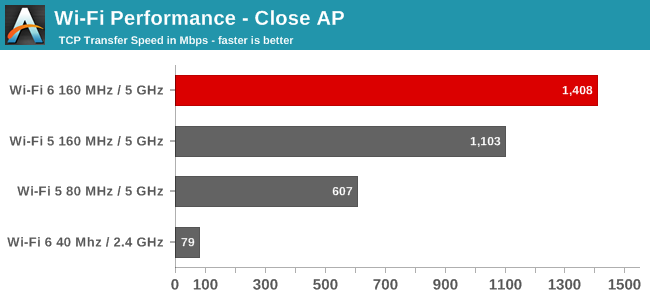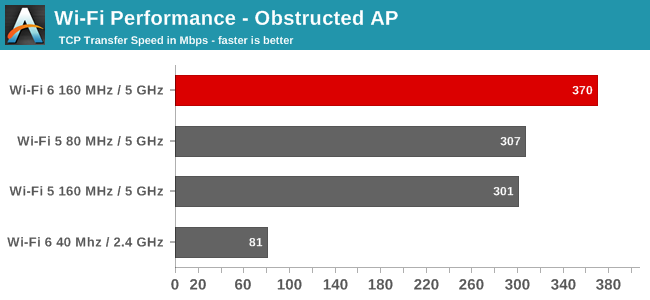AT 101: Wi-Fi 6 And Why You Want It
by Brett Howse on February 12, 2020 8:00 AM ESTPerformance
In order to achieve maximum performance, the latest Wi-Fi 6 standard leverages 1024-level QAM, but depending on the signal strength and quality it will scale down as needed, so to achieve the best performance very high signal to noise ratios are going to be required. Since 5 GHz is attenuated dramatically when it has to go through walls, if you need maximum Wi-Fi performance be aware that you are going to want your wireless router as close to the end device as possible. Luckily that is not an issue in our case, since the router is in the same room when testing for maximum performance, but we’ll also evaluate it in less than ideal scenarios as well.
Wi-Fi 5 vs Wi-Fi 6 – Close AP
First up we’ll test the TCP performance when the Access Point is in the same room as the client.

The performance advantages of Wi-Fi 6 are clear. With the access point in the same room, the SNR is very good and the new 802.11ax standard can really shine. With 1024 QAM and 160 MHz channels, the performance is over twice as fast as the outgoing Wi-Fi 5 with 256 QAM and 80 MHz channels. It is very impressive to see a typical 2x2:2 connection well over the Gigabit barrier, and even though the AX200 network card is the first generation, Intel has already done a fantastic job tuning it. The theoretical maximum transfer rate with 160 MHz channels and 1024 QAM is around 1200 Mbps per connection, so a 2x2 can in theory hit around 2.4 Gbps, meaning there's still room for improvement. Since 802.11ax also can be used on the 2.4 GHz frequency, unlike 802.11ac, the same test was also done on 2.4 GHz, and the results were disappointing. 2.4 GHz can still offer 40 MHz channels, but it doesn’t seem like the AX200 could take advantage of any of that. For reference, the wireless adapter in the laptop was reporting -21 dBm, which is a strong signal, which makes sense since the AP is almost right next to the laptop.
Wi-Fi 5 vs Wi-Fi 6 – Reduced Signal
Moving the laptop further away, and adding several walls and doors in the way to attenuate the signal, the same scenarios were again tested.

With some walls in the way, 5 GHz gets attenuated quite dramatically, and the SNR in the second location was -78 dBm. With such a low signal, the Wi-Fi 6 connection wasn’t able to take advantage of the 1024-level QAM and would have had to drop down to a much lower set, reducing the number of bits per tone, and even though the total channel bandwidth was still 160 MHz, it was only marginally faster on 802.11ax than 802.11ac 80 MHz. 2.4 GHz is not as impacted by walls, and as such was able to maintain the same transfer rate, even though it was still quite a bit slower.
So the results are clear. Wi-Fi 6 can offer a significantly higher level of throughput than Wi-Fi 5, but in order to do so, it needs a strong signal. The Wi-Fi 6 still outperformed the Wi-Fi 5 in the second test with an attenuated signal, but the performance gain was minimal. 2.4 GHz still offers the best signal strength, and therefore would be able to connect further away, and through more obstacles, but doesn’t offer anywhere near the performance of the 5 GHz range. It will be interesting to see the Wi-Fi 6E devices with 6 GHz support when they launch. It will open up Wi-Fi to a wider set of frequency choices, but will offer even less range.










149 Comments
View All Comments
Samus - Thursday, February 13, 2020 - link
I have yet to see a residential media converter that has >1Gbps throughput, let alone >1Gbps port. I have AT&T Fiber here in Chicago and get 980Mbps\960Mbps from my Gigabit connection and it's mostly bragging rights...no sites, even my private torrent community, can actually feed my connection.Though that could be a limitation of the AT&T backend for residential service. I have no clients in the city with commercial gigabit connections so I have nothing to compare it too.
TheUnhandledException - Friday, February 14, 2020 - link
because in any realistic scenario you aren't going to hit 1 Gps data rate. The 160 MHz tests in the article are next to useless in anything but the most remote scenarios. While Wifi 6 with 160 channels and devices a few feet away can exceed 1 Gbps under any realistic scenario (80 MHz, 15 feet away, wall between device and ap) you are going to be in the 300 to 600 Mbps range.hescominsoon - Friday, February 14, 2020 - link
Because not many folks have multi-gig for their wan connections so the invested the money into a 2.5 gig lan port instead.valinor89 - Wednesday, February 12, 2020 - link
My usual question is, can the WIFI 6 advantages be of use if there are less advanced devices in the same network? It used to be that even if both the AP and Device support the highest standard as long as there exist other devices that use the same network that don't support the new features they end up not usable.haukionkannel - Wednesday, February 12, 2020 - link
Those devices that support Wi-Fi 6 does benefit even if there Also Are those older devices. The router can handle both / all types of trafic at the same time.5080 - Wednesday, February 12, 2020 - link
Make sure your router support DL OFDMA. Some WiFi 6 router need a firmware update to add OFDMA.Makaveli - Wednesday, February 12, 2020 - link
I'm also using an RT-AX88U on Merlin firmware i'm picking up a Galaxy S10 today which is has AX so will be testing that tonight.spamcops - Wednesday, February 12, 2020 - link
I dont want 802.11ax, I want 802.11ayhaukionkannel - Wednesday, February 12, 2020 - link
Just wait some years and you have it!spamcops - Thursday, February 13, 2020 - link
yep, that will be revolution!